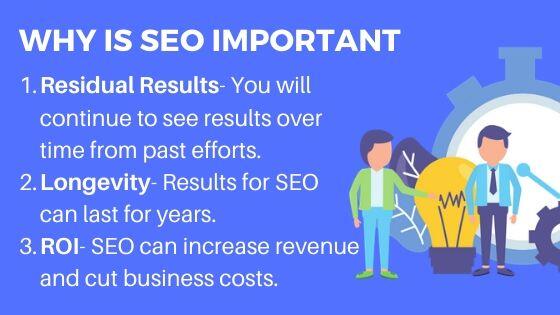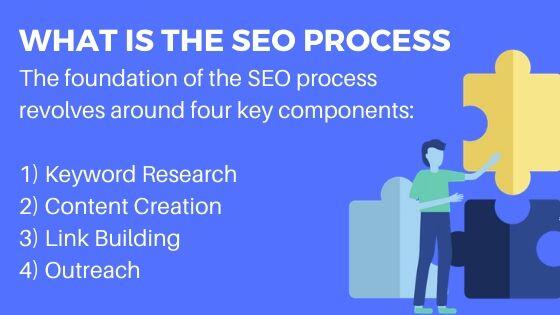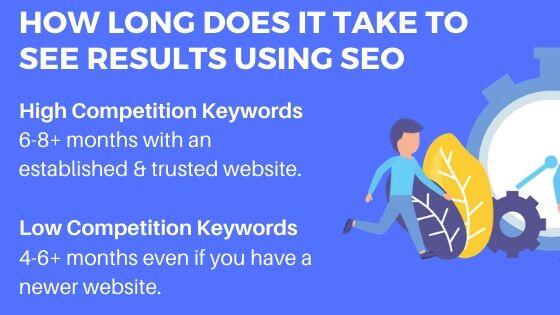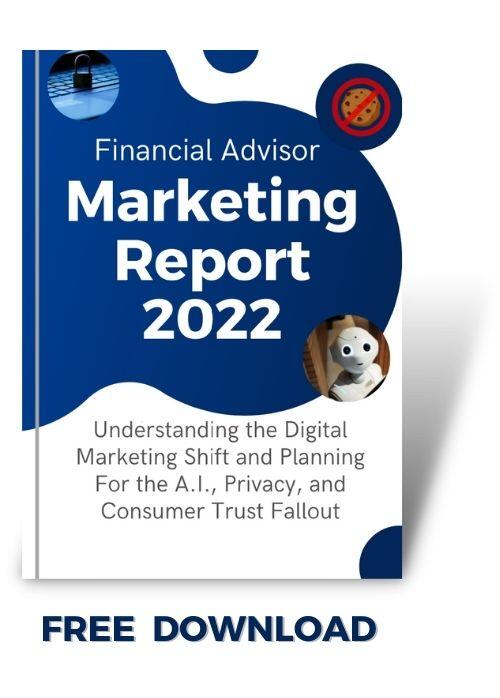SEO for financial advisors is one of the many ways to drive traffic to your website.
But more than the traffic it brings, it’s one digital marketing strategy that can help deliver high quality leads to your business for years to come.
In this guide, l walk financial advisors through the nitty-gritty with a ton of SEO tips. Here, you’ll get a better understanding of what SEO is and why it is essential for financial advisors long term strategy.
By the end of this piece, I’ll help you make an informed decision on which is the best route to take for your business or blog.
To begin, let’s start with what SEO is.
What is SEO
SEO stands for search engine optimization. It is the practice of optimizing great content so that your website is discovered in the search engine results page (SERPs).
The goal of your SEO strategy is to drive ‘earned,’ ‘unpaid’ organic traffic to your website.
In simpler terms, you make specific changes to your website to make it more appealing in search results such as Google, Bing, and Yahoo. And what do you get in return?
Those search results will display your financial advisor website on top of the SERPs.
It helps show your business in front of your potential clients as they search for what you have to offer.
And this means more targeted people are seeing and clicking links to your website based on past work.
Optimizing for search engines increase both the quality and quantity of a website’s traffic. It also helps financial advisors gain exposure to their brands without continued spending on ads.

Why is SEO Important
There are many other ways to drive traffic to your website, aside from SEO. But why should financial advisors optimize for Google search?
Your SEO strategy makes an impact that can last more than several years.
While paid advertising, social media, and other online marketing strategies can drive traffic to your website.
They last for a relatively shorter time compared to good SEO.
This is especially true for paid advertising that gives immediate results but disappears completely once the campaign ends.
The more time, effort, and budget financial advisors spend on your SEO strategy, the better and longer your website will enjoy consistent organic traffic.
But the importance of SEO doesn’t just end there. Optimizing for Google search also gives a financial advisor 20x more traffic opportunities than PPC on both desktop and mobile. This is when your website appears in organic search results.
Organic search plays a critical role in getting users to engage or convert. To put that in numbers, 40.9% of Google searches get an organic click for mobile devices.
That’s a huge difference compared to the mere 2% of paid clicks. For desktop devices, it’s 62.2% organic versus 2.8% paid clicks.
These are only a few of the many reasons why you should utilize SEO for financial advisors.
Types of SEO
There are two types of search: organic and paid.
As stated above, organic means unpaid, natural first page rankings in search results. Paid search, as the name suggests, focuses on paid rankings.
Organic search can be optimized with various SEO practices. Meanwhile, traffic from paid search can be acquired through search engine marketing (SEM).
For this guide, we will focus on organic search and discuss the different types of SEO.
On-Page SEO Tips
On-Page SEO involves optimizing the content on your website.
Optimizing each page on your website helps algorithms understand the topic of the content you are publishing.
This tells search engines that your website is relevant to people who are searching for specific terms.
In this type of SEO, a financial advisor would do the following:
- Keyword Research – Looking for keywords to include on a page (more on this later).
- Content Creation – Publishing high-quality, informative content revolving around the keywords.
- Keyword Optimization – Adding the keywords in strategic places in the content. Avoid keyword stuffing and only add them where it makes sense.
- Website Design – A clean easy to navigate website will offer a good user experience which will keep people on your site longer. which helps with rankings.
For On-Page SEO, excellent content is key to higher rankings in the SERPs.
According to Rand Fishkin of SparkToro (formerly with Moz), your content should be ten times better than other content available on the results page.
That and a couple of relevant and related keywords.
Areas of On-Page SEO
To find success in this type of SEO, financial advisors must pay attention to these best practices that will help increase your first page rankings, traffic, and conversions.
Title Tag
Title tags are an HTML element the shows the title of your web page. Along with meta description, they appear in search results like this:

Meta title tags are crucial because they help search algorithms understand what your page is about.
This is why it’s vital that you follow the SEO best practices for optimizing title tags, such as including your target keywords.
SEO aside, they also leave first impressions on the people looking on search , which can be a make-or-break factor on whether searchers will click on your link.
Meta Description
Located just below the title tag, meta descriptions explain what your page is about. It is the longer version of the title tag.
Just like the first HTML element, meta descriptions also tell search algorithms what the topic of your content is.
Meta descriptions also need keywords to rank your page in the SERPs.
Header Tags
Header tags are HTML elements H1-H6 that’s long been a fixture of SEO, but most people know a little about.
But what exactly are header tags?
These HTML elements are used to determine headers and subheadings within a content. Just take a look at the illustration below.

While header tags aren’t as critically important for site rankings as they used to be, they still serve a role that can indirectly influence your rankings.
Header tags indirectly impact rankings by:
- Making content more scannable for an easy read.
- You are sending the right signals to search engines about what topic your content contains.
Image ALT Tags
People visiting your web page can physically see the photos published on your site.
But search engines can’t. And this is where image ALT tags come in handy.
ALT tags, otherwise known as “alt attributes” or “alt descriptions,” are HTML code and text that you add to describe an image.
If you include keywords in these tags, search algos will easily determine what your photos are about.
These tags are vital because they not only make for better user experience, but they also contribute to image SEO.
ALT tags lend search engines a helping hand by describing what an image is about through keywords.
Internal Links
These are hyperlinks that direct to another page on the same website.
Internal linking is an essential step in SEO for the following reasons:
- It allows for more straightforward navigation on the website.
- It helps establish site architecture for the given website.
- It helps distribute link juices around web pages.
Both internal and external (more on this later) links send search signals about the topic of your content. But internal ones are used to show relationships between content.
As search engines determine such relations, they work on ranking your most essential pages higher in the SERPs.
Page Speed
Page speed is another important ranking factor that Google is looking for. It is the measurement of how fast your web page content loads.
Page speed is often described as “page load time.”
A page’s loading time is dependent on several factors, such as image compression, page file size, and the site’s server.
Google penalizes pages with longer load times, which tend to have a lower average time on page and higher bounce rates.
It’s crucial that you follow the SEO best practices on increasing your page speed. This includes enabling compression, reducing redirects, and improving server response time, among others.
Now it’s more critical than ever that your website is mobile friendly.
The top priority of a mobile friendly website is to be sure it loads in less than 4 seconds on a 4G connection.
Financial advisors can use this free tool by Google to test your mobile site, Think With Google.
Off-Page SEO Tips
Off-page SEO involves optimizing efforts outside of your website. Unlike on-page SEO, a financial advisor often does not have control over off-page SEO.
For instance, you reached out to an authoritative website to link to your website.
That’s off-page SEO. It is considered off-page because you didn’t change anything about your website.
Off-page SEO is vital because it touches many off-page factors that help rank a website. Some of the most important of these factors include the following.
Links
Building links is at the core of off-page SEO. This is because links are one of the most important ranking factors for Google.
Links are crucial because search engines use them to discover new web pages.
They are also used to determine how well a page should rank in the SERPs.
Search engines look at the number of links from external websites pointing to a page you are trying to rank.
These links tell search engines if the page has sufficient quality to rank for relevant keywords.
In general, the more high-value links you build, the better you rank in the results page.
We will discuss link building in great detail at What is the SEO Process section. Keep on reading to learn more about this process.
E-A-T
E-A-T in SEO stands for Expertise, Authoritativeness, Trustworthiness.
It is one factor in determining Page Quality. Search results display pages if it has a beneficial purpose.
If it does, it’s E-A-T level is considered whether the content is YMYL (Your Money or Your Life).
This ranking factor matters on topics such as YMYL, which include pages that can potentially impact a searcher’s safety, financial stability, health, and happiness.
And what do these all mean? It all boils down to links and high-quality content.
Writing blog posts is a great way to help Google understand you are a financial advisor that deserves high E-A-T.
As mentioned above, links are crucial to rank higher in the SERPs. And it’s not just any link; it should be linked from high-quality content.
For you to create high-quality content, you need to look at your E-A-T.
As a financial advisor, you fall into this YMYL category. For this reason personal branding can be extremely helpful in establishing you E-A-T.
Social Engagement
Google made it clear that social media is not a direct SEO ranking factor.
But despite this, there’s still a connection that indirectly affects how Google sees your content.
Engagement metrics, like “shares,” play a role in SEO. How? The more social shares you get, the more visibility of your content gets.
And visibility sends the right signals if your content is high-quality and relevant to the keywords you are targeting.
That said, social engagement impacts SEO. And you should also pay attention to this when trying to rank on the results page.
Local SEO
Statistics show that 46% of all Google searches are local. And how do you take advantage of these searches? Through local search engine optimization.
This is the process of optimizing content to drive traffic organically. But in this type of SEO, you are targeting more relevant local searches.
Investing in local search engine optimization is vital because 80% of local searches result in conversions.
And 50% of people who made those searches visit a store within a day after conducting a local search.
As a financial advisor, if a person makes a local search like, “financial advisors near me,” you have a better chance get found by potential clients in your area.
That means an opportunity to convert, so you shouldn’t miss out on local SEO.
Important Parts of Local SEO
The process is not all that different from organic SEO. This involves taking the following steps to optimize your content for local searches.
- Create a Google my Business listing
- Performing keyword research
- Creating content and blog posts with a local focus
- Acquiring high-quality links
- Outreaching
Note: A Google My Business listing is very simple to set up and depending on your market is one of the easiest ways to rank higher and improve your online presence.
These steps will be discussed in great detail in the What is the SEO Process section.

What is the SEO Process
Now that you have an idea of the types of SEO, it’s time you get an overview of how the Search Engine Optimization process goes.
How Search Works
Search engines rank a website in three primary steps:
- Crawl – search engine crawlers scour the Internet for content
- Index – search engines process and store information they find into a huge database called an index
- Rank – from the index, the best answer (aka most relevant) for each search query is displayed with the first spot being most relevant to your search
For crawlers to rank your website higher in the SERPs, you have to optimize your content. How? Through the steps below:
Keyword Research
SEO campaigns usually start with keyword research.
Keyword research is the process of finding words and phrases that your target audience enters into the search bar.
It involves analyzing those search terms to help you develop an informed content and marketing strategy.
The ultimate goal of this process is to optimize content around those keywords. You do this, so your website ranks in the SERPs.
Importance of Keyword Research
Keyword research is crucial because it tells you what topics your customers care about.
It also gives you relevant data like search volume that tells you how popular those topics are to your target people.
Determining the intent behind each search term also lets you identify what sort of content you should create to resonate with your target audience.
By researching keywords for their search volume and intent, you get insight into what answers people are looking for.
You get a clearer view of what you should consider in the next steps of the SEO process.
It is like a compass that tells you where to go when doing content creation, outreach marketing, and promotion, among others.
The Keyword Research Process
SEO specialists usually take the following steps to discover search terms.
- Making a list of relevant topics for your business.
- Research keywords that fall into those topics.
- Discover related search terms.
- Come up with a mix of head terms and long-tail keywords for a balanced strategy.
- Use keyword tools like SEMrush to check how competitors rank for specific keywords.
- Refine your keyword list based on search volume, general intent, and trends.
Content Creation
Once you have your keywords sorted, the next thing to do is to create great content and high quality blog posts.
SEO speaking, content must be of high-quality and should contain useful information to your niche audience.
Remember that when searchers type a query, they are looking for a ‘relevant’ answer.
If you want to rank on the results page, your content must be able to provide answers that are of value to searchers.
Importance of Content Creation
In online marketing, content is ‘still’ king.
The search results mission is to compile and organize information and to present the best possible answers to questions.
That’s why content should be useful and relevant to searchers. And the ‘best’ answers are always rewarded in the search results in the form of a higher page ranking.
Simply put, content with SEO value, ranks higher in the SERPs. So, you should work on creating optimized, valuable content.
And by optimized, we mean strategically placing relevant keywords on the content you are creating.
Different Forms of Content
There are different forms of content, and they work differently depending on your audience.
Remember that each industry is different. One industry may find blogs to resonate with its audience.
In contrast, others may notice videos to be an effective form of content that drives results.
The idea is to find what content appeals to your audience. Because the more it appeals to them, the better your content will do in the search results.
Below, we rounded up some of the most common types of content that work best for SEO.
- Web Page Content
- Video Content
- Blog Posts
- Long-Form Articles
- Evergreen Content
- Photo and Visual Galleries
- Podcast
- Social Media
- Local Listings
Link Building
After creating content for your audience, the next to do is to build links to your website.
As mentioned above, links are one of the most important ranking factors that Google has established for SEO.
Now, let’s talk about external links, aka inbound links or backlinks.
Importance of Links
Inbound links are links that point from one website to a page on another website. They are like “votes” for a specific page, acting as a real-life reputation.
To put it simply, think of links as people. Say, you asked five people what the best diner in town is. Then, they all said,
“Steven’s Kitchen in Manhattan.” In your mind, you would trust Steven’s since people are vouching for it.
This is what links do for search results. These links signal to search engines that other website trusts your content.
And the higher the number of links that point to your website, the higher you appear on organic search engine rankings.
Ways to Build Backlinks
Link building can be done in several methods, and Moz has provided an exhaustive list to help you build high-quality backlinks.
To give you an idea, we rounded up some of the most popular strategies that tend to work for most campaigns.
- Publish a blog
- Find customer and partner links
- Create unique resources
- Build resources page
- Refurbish top content
- Get involved in your local community
- Be newsworthy
- Be personal and genuine with outreach
Outreach
Aside from link building, outreaching is another way to help businesses rank for their chosen keywords, thus attracting organic traffic and more potential clients.
But what exactly is outreach in SEO?
Outreach is technically one way to do link building. In this method, you reach out to people to create valuable backlinks from third-party sites.
Other than gaining traffic, doing outreach also helps businesses build credibility within their respective industries.
Often, businesses also perform outreach to improve brand awareness. This is done in several ways, like earning a mention from influencers and press releases, among others.
Importance of Outreach
Outreach is crucial in SEO to stand out from the crowd.
As more and more digital marketers create content for link building, the supply of content is now significantly exceeding demand.
It is up to the outreach specialist’s skill to identify strategically valuable publishers and convince them to accept and promote their content.
When you do this correctly, you may enjoy high-quality backlinks to your website. And that means better ranking and more organic traffic for your web pages.
Ways to Perform Outreach
Businesses can outreach in various ways. This includes the following strategies:
- Email outreach
- Social outreach
- Influencer outreach
- Press outreach
Is SEO Difficult
With all the steps mentioned above, you’ve probably guessed: SEO is complex.
Learning its process by yourself demands a significant amount of time and attention. You might even have to spend months just to learn the basics and find your footing in this online marketing strategy.
This is why many financial advisors are too intimidated to take on SEO themselves.
But you know that SEO is an excellent investment. So, what should financial advisors do?
Seek help from the professionals or join a community that can help you on your journey.
Marketers who have spent enough time mastering the optimization method offers you better chances of achieving your business goals through SEO.
Should You Hire Someone for SEO
If you are a financial advisor who doesn’t have the luxury of time to spend on learning SEO from scratch, it’s probably best you hire an expert or marketing agency to optimize your website.
Pros of Hiring Someone for SEO
You get someone who has a full understanding of SEO
When you hire someone for SEO, you acquire valuable digital marketing knowledge that will help you achieve your business goals.
You are getting someone with advanced skills that can work hand-in-hand with you.
You get someone who is updated on current algorithmic changes
Search engine algorithms are an ever-changing element that you need to keep up with.
And staying up-to-date is one of the many offers that an SEO specialist can bring to the table. Using outdated tactics can hurt your rankings.
You get someone to talk to within your business
Got an in-depth question about SEO? Feel free to discuss it with an SEO expert. Having someone to do SEO for you means you can explore ideas that might work best for your business.
There is not a one method works for all approach in SEO. Strategically piecing together business goals with SEO could be the thing that helps you stand out to algorithms.
Quicker Return on Investment
SEO is an investment that, when done right, gives excellent returns.
Depending on your business goals, SEO can provide some of the best returns in online marketing.
For instance, one case study shows how a website saw an average of 140,000+ organic visitors per month from the previous 20,000.
That’s an increase of 600%, boosting the client’s brand awareness and, ultimately, their revenue.
Cons of Hiring Someone for SEO
SEO takes time to get results
As we will discuss below, SEO is a commitment that take some time. It takes months or even years to pull off.
Be mentally prepared to commit to 6 to 12-months for superior results.
SEO Is Complicated
Many factors contribute to the success of an SEO campaign.
If you’re hiring someone to do the job for you, you will have to rely on that person’s skill to get results.
That’s why it’s crucial to find an SEO expert with experience and someone whom you feel you can trust to deliver results.

How Long Does It Take to See Results From SEO
If you’re hiring SEO experts to work for you, know that there is a baseline period for you to see results from your optimization efforts.
Ask some SEO agencies, and they will tell you that it takes 6 to 8+ months to rank for high competition keywords.
High competition means keywords that have high search volume that often convert well into visitors or purchases.
Many marketers and advertisers bid for high competition keywords because of its opportunity to convert, gaining huge traffic and sales. Thus, the term “high competition.”
In contrast, it may take you 4 to 6+ months to rank keywords with lower competition. By lower competition, it means terms that have relatively lower search volume.
Low competition keywords often rank easier in search results because fewer marketers and advertisers are bidding for them.
Ranking low competition terms usually take little to no link building and no domain authority.
As a general rule of thumb, it is best to find high volume keywords with low competition during the keyword research phase.
These keywords give businesses a chance to rank on the results page.
With that said there is value in using keywords that have low volume with low competition as well.
I recommend this more for newer sites that are still growing and building their E-A-T with Google.
The financial services industry as a whole is very competitive and the sooner you start working on your optimizing your site the better.
How Much Does SEO Cost
The cost of SEO services depends on what is included in the package.
Services are based on the scope of a project, but just to give you an idea, the typical SEO campaign cost in 2020 is around $750-$2,000 per month.
One-time projects cost around $5,000-$30,000. Hourly rates for consultants are priced between $80-$200.
Wrapping It Up
Now that you have a better understanding of SEO, it’s time to decide which is the best route for you to take for your needs.
Decide whether to take it upon yourself or hire someone to do SEO for you.
But here’s a piece of advice: if you want to increase your chances of success in this strategy, it’s best that you seek the help of an expert.
Attracting Better Leads Online
Our 2022 Marketing Report is 100% Free! Learn what it takes to be successful online with all the digital changes happening right now!
(No Email Or Anything Required)







Hi Steve,
A long informative piece as usual.
SEO is the source of organic traffic and hands down organic traffic beats any kind of traffic (paid or social).
Newbies thought SEO is complicated, the complicating part is being consistent and never giving up.
If there’s one thing I am happy about in my digital marketing journey, it is that I already Know SEO takes time and I am not in haste to see results.
This is a masterpiece steve…you nailed it.
Thanks for the mention
Cheers, Folajomi
Hi Folajomi,
I agree SEO delivers the best quality traffic to a website. You just have to make the right moves and be patient until eventually, your hard work starts to pay off.
I appreciate you stopping by.
Take care,
Steve